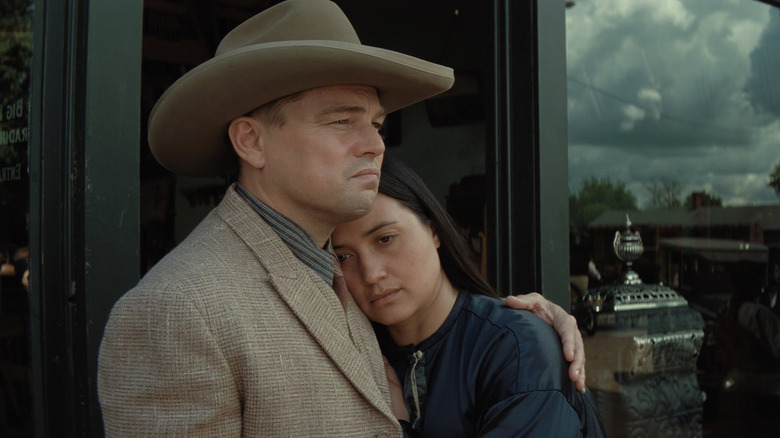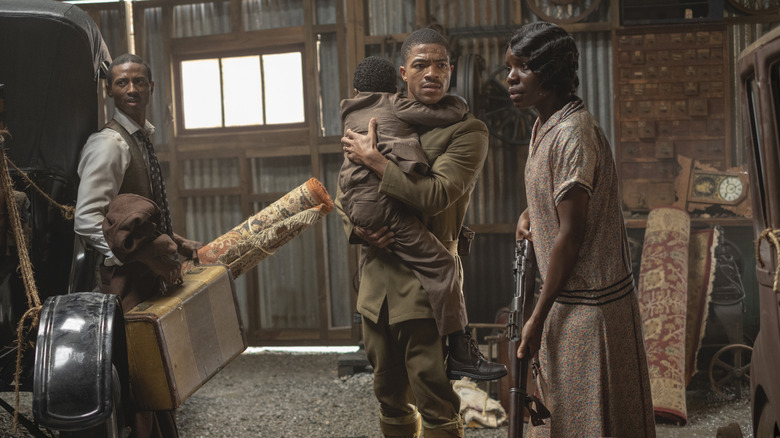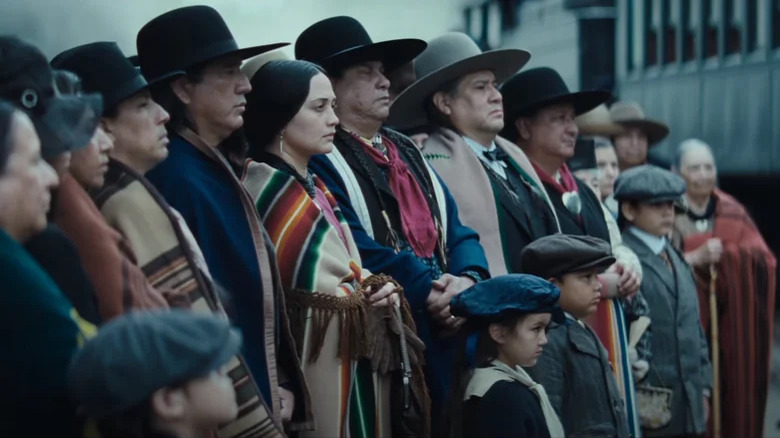How Killers Of The Flower Moon Connects To The Tulsa Massacre Highlighted In Watchmen
This article contains spoilers for "Killers of the Flower Moon."
Martin Scorsese, one of our finest living filmmakers, returns to a theme he's made his own for decades in "Killers of the Flower Moon" – the American dream and the fallacy in its formation. This time, the focus is not on white men gaining wealth, fame, and power through less-than-scrupulous means, though there is still plenty of that happening, but there's a stronger emphasis on how the realization of the American dream often means ruin, death, and doom for communities of color.
In the film, we see this with the Osage Nation, a Native American tribe residing in present-day Oklahoma after being removed from Kansas by the U.S. government. The Osage found oil on their land in the early 20th century, which they retained the rights for, resulting in many members of the Osage Nation becoming rather wealthy. It's here that Scorsese flips his usual script on its head. Rather than a show of debauchery wherein the white outsiders scheme their way into fame and fortune, he frames the story from the side of the Osage, making it a tale more tragic than any of his previous work.
There is no opportunity for "Killers of the Flower Moon" to make us sympathize with Robert De Niro's William Hale or even Leonardo Di Caprio's Ernest Burkhart the way we do with Henry Hill in "GoodFellas" or Jordan Belfort in "The Wolf of Wall Street." That's because, from the beginning, they are framed as ruthless monsters, their deception and misdeeds are not framed as fun, but depicted as tragic and paid in blood.
But the tragedy doesn't just end with the Osage. In the film, we hear news of a similar tragedy that falls a community of color after they achieve the so-called American dream, a tragedy that has re-entered the spotlight in recent years thanks to shows like "Watchmen" and "Lovecraft Country" on HBO: The Tulsa Race Massacre of 1921.
The cost of the American dream
In 1921 the Oklahoma neighborhood of Greenwood, known at the time as "Black Wall Street," was attacked by mobs of white supremacists. The massacre unfolded on May 31 and June 1, with mobs attacking Greenwood's Black residents and businesses, both from the street and from private airplanes in the air. Some of the terrorists were even appointed as deputies by government officials and armed by them. The total number of deaths has been disputed over the decades. In 1921 there were only 36 reported deaths, but the number is now estimated to be in the hundreds.
Tulsa, like Osage County, was rich in oil, and Greenwood supported a large number of affluent Black residents. The massacre went largely hidden for decades. It was not taught at schools, nor widely discussed or even acknowledged. It wasn't until the riot's 75th anniversary that a commission was established in Oklahoma to investigate the attack, delivering a report in early 2001. For many Americans, it wasn't until the 2019 "Watchmen" TV show that they really learned about the riots. The same thing is happening with "Killers of the Flower Moon," a true story not many people know about.
Both of these stories are thematically linked. Lily Gladstone's Mollie mentions the Tulsa Race Massacre as another example of oil and quick economic growth being more a curse than a blessing, because the two are intrinsically linked in "Killers of the Flower Moon." William Hale himself sees a news reel in movie theaters about the event, and he later references it as a way of trying to spread suspicion of crimes to other parties.
Scorsese takes us to school
"Killers of the Flower Moon" even begins with the very idea of Osage history being forgotten. In the first scene, Osage leaders mourn that their children will lose their culture, as they're going to be taught by white people. The very next scene is about the discovery of oil on Osage land and how the community is getting rich. What is supposed to bring them prosperity, instead, brings them death.
That is the crux of the film. Early on, a black-and-white film reel introduces us to the Osage, the "richest people per capita on earth," how lucky they are that oil was discovered on their land, and the fact that they control every aspect of it. Almost immediately, we start seeing them pay for that "luck" as the murders begin, and their community is torn apart.
Like Black Wall Street, these communities fall victim to violent crimes just because of their affluence. Like most of Scorsese's films since "Mean Street," the American dream only comes true for the cruel, and it often results in tragedy for someone else.
"Killers of the Flower Moon" is playing in theaters now.


